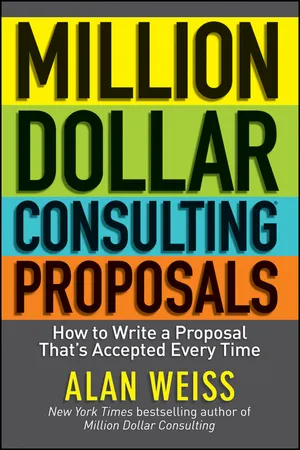
Million Dollar Consulting Proposals
How to Write a Proposal That's Accepted Every Time
- English
- ePUB (mobile friendly)
- Available on iOS & Android
About this book
Bestselling author of Million Dollar Consulting shares the secrets of writing winning proposals
Intended for consultants, speakers, and other professional services providers, Million Dollar Consulting® Proposals ends forever the time-consuming and often frustrating process of writing a consulting proposal. It begins with the basics—defining these proposals and why they are necessary—and coaches you through the entire proposal process. In this book, you'll learn how to establish outcome-based business objectives and maximize your success and commensurate fees.
From bestselling author Alan Weiss, Million Dollar Consulting Proposals delivers step-by-step guidance on the essential element in creating a million dollar consultancy.
- Outlines the nine key components to a Million Dollar Consulting proposal structure
- Presents a dozen Golden Rules for presenting proposals
- Offers online samples, forms, and templates to maximize the effectiveness of these tools
- The New York Post calls bestselling author Alan Weiss "one of the most highly regarded independent consultants in America."
Alan Weiss's expert guidance can lead your consulting business to unprecedented success, and it all starts with a million dollar proposal.
Frequently asked questions
- Essential is ideal for learners and professionals who enjoy exploring a wide range of subjects. Access the Essential Library with 800,000+ trusted titles and best-sellers across business, personal growth, and the humanities. Includes unlimited reading time and Standard Read Aloud voice.
- Complete: Perfect for advanced learners and researchers needing full, unrestricted access. Unlock 1.4M+ books across hundreds of subjects, including academic and specialized titles. The Complete Plan also includes advanced features like Premium Read Aloud and Research Assistant.
Please note we cannot support devices running on iOS 13 and Android 7 or earlier. Learn more about using the app.
Information
Chapter 1
Business Vows
What Is a Proposal and Why It Is Necessary
What They Can Do and What They Can’t Do
- Summarize and convey formally the conceptual agreements reached in discussions to that point between you and the economic buyer.
- Detail the objectives of the project.
- Provide for the metrics of success.
- Describe the value that will occur once the objectives are met (both personally and professionally).
- Supply options from which the buyer can choose to determine the amount of value sought in return on the investment (ROI) committed.
- Stipulate fees, expense reimbursement, and payment terms.
- Enable immediate acceptance in writing.
- Enable a nonbuyer (gatekeeper, HR, or training person) to proceed to a buyer on your behalf.
- Establish your credibility.
- Establish a relationship with a buyer.
- Serve as a point of comparison for competitors’ proposals.
- Offer vague promises or results and outcomes.
- Include agreements that the buyer has not agreed to prior.
- Serve as a “take it or leave it” alternative.
- Cite legal provisions and covenants.
- Be valid and acceptable without time limits.
- Serve as an agreement for nonvalue relationships, such as pricing by day, participant, materials, labor, and so forth.1
Their Place in Your Business Model

- The buyer shares personal and nonpublic information.
- The buyer asks your advice.
- You and the buyer challenge each other’s assumptions.
- You feel free to interrupt each other without ill feelings.
- The buyer does not allow interruptions when with you.
- The buyer admits to uncertainty or a welcome new view from you.
- Deliverable: Strategy retreat.
- Outcome: New strategy to penetrate overseas markets.
- Deliverable: Coaching for senior vice president.
- Outcome: Improved presence with media to improve company reputation.
- Deliverable: Focus groups.
- Output: Gain customer contributions for best features that will improve sales in product reinvention.
- Deliverable: Strategy retreat.
- Outcome: New strategy to penetrate overseas markets.
- Metric: All P&L leaders create support for strategy within two weeks.
- Deliverable: Coaching for senior vice president.
- Outcome: Improved presence with media to improve company reputation.
- Metric: More positive articles appear in trade press resulting from his appearances.
- Deliverable: Focus groups.
- Output: Gain customer contributions for best features that will improve sales in product reinvention.
- Metric: Five innovative ideas that both R&D and sales support with their budgets.
- Deliverable: Strategy retreat.
- Outcome: New strategy to penetrate overseas markets.
- Metric: All P&L leaders create support for strategy within two weeks.
- Value: Global presence will improve profit, diversify exposure to volatile markets, and attract new labor pools.
- Deliverable: Coaching for senior vice president.
- Outcome: Improved presence with media to improve company reputation.
- Metric: More positive articles appear in trade ...
Table of contents
- Cover
- Title page
- Copyright page
- Acknowledgments
- Introduction
- Chapter 1: Business Vows
- Chapter 2: Five Steps Toward Great Leaps
- Chapter 3: Avoiding Gatekeepers, Intermediaries, and Goblins
- Chapter 4: The Architecture of Successful Proposals
- Chapter 5: One Dozen Golden Rules for Presenting Proposals
- Chapter 6: Why Bad Things Happen to Good People Who Wait
- Chapter 7: First, Let’s Kill All the Lawyers
- Chapter 8: The Dreaded RFP (Request for Proposals)
- Chapter 9: Retainers Are to Projects as Montrachet Is to Thunderbird
- Chapter 10: In the Unlikely Event You Need Oxygen
- Virtual Appendix
- Sample Proposals
- Index